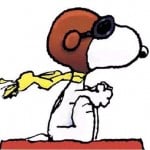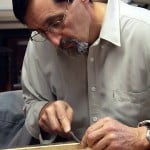Stock prep and gluing up a panel
Welcome! / Forums / General Woodworking Discussions / Wood and Wood Preparation / Stock prep and gluing up a panel
- This topic has 15 replies, 8 voices, and was last updated 11 years, 1 month ago by
 Dave.
Dave.
-
AuthorPosts
-

I’m starting to work on a big chest and have purchased some inexpensive rough pine 1×12. I’m wondering what is the proper way to get these glued into a panel, should I joint two edges and glue two pieces together then plane them flat and true or should I prepare them flat and true before gluing up?
8 March 2013 at 10:37 pm #9035This is what I have done on a couple projects. Joint my edges, then glue and clamp. After they have dried I then flatten my panel. I am not sure this is the correct method as I am fairly new to hand tools, but seems to work for me.
Steve

 8 March 2013 at 11:42 pm #9040
8 March 2013 at 11:42 pm #9040I make sure the pieces are all flat, working out any defects first, then joint the edges square to a flat side and glue together.
A final finishing will be done after the boards are all glued up.Be careful that you don’t make a defect worse by gluing together two bad boards. For instance, a single board may have 1/8″ of camber in it, if you glue two pieces together with the same defect, you could end up with a pannel with 1/4″ to 3/8″ camber in it.
9 March 2013 at 12:40 am #9044I’ve only make a few panels but I’ve tried to get them flat before glue up knowing that my glue up isn’t going to be perfect and I’ll need to plane again.

 9 March 2013 at 4:44 pm #9068
9 March 2013 at 4:44 pm #9068Draw on a piece of paper a board with a cup – one side is cupped (concave) and the other side is bowed (convex). (I am not going to mention twist because it adds to the complexity and I am trying to keep my thoughts simple her. You will get the idea.) When you plane the board flat, you can radically change the actual dimension of the board. You will plane down to the bottom of the valley on the cupped side and down to the edges on the bowed side getting a fraction of the actual board side.
When watching Paul’s videos for the projects, he is already using planed square boards. Sure he gives them a quick planing to remove the snipe, but, with his plane being flat, he is not changing the squareness of the boards he is using by any significant amount.
I work with someone who gives me boards 3/4 x 6 x 18 that he ocassionally receives as part of a project that he teaches. Genreally, they are pine and on ocassion he gets a piece of poplar. Anyway, beng new, I watched Paul’s videos, grabbed two boards and tried to make a dado. Then I tried to make dovetails. No surprise, gaps. I took the boards as is because they looked flat. Duhhhh!!!! I did not think much about it for the dados because they were relatively easy to make, the gaps were small and the edges of the slight bow and high point of the cup kept the board in place. I went to Home Depot, bought the more expensive select pine instead of premium pine, made the shooting board and felt comfortable with it. (I took the time to check for flat and square which started me thinking.) There is a huge difference betrween the select, premium and common board pine at Home Depot and you get what you pay for.
Dovetails were a different story with the wood I was being given. I was taking pains to markup square and cut square when I cut the tails. When I went to markup the pins, I thought I was okay except that I kept noticing that my pencil line for the thickness of the mating pieces were different from when I used a square. When finished, gaps on ends, gaps in middles, arghhh!
So I started to think about it. Out came the ruler. Ever so slight bows in the middle!!!!
Now I am needing to learn how to plane flat and sqaure. Out comes the pencil, paper and picture drawing, That leads me right back to the beginning of this post. That 3/4″ board when planed flat was no longer 3/4″ in actual dimension. It was much less. I will admit I am probably planing more than I need to at this point, but, I am learning by trial and error.
Now we come to the relevant point, The edge dimension is different which is acceptable and I can plane both boards almost to the same dimension which is fine. However, when I put the faces together, they are flat together. Now when I match plane the two boards, the offseting angles will give me an even edge when I go to glue up.
But, what if I did not plane the boards first before match planing? The planed agles will still be the same. The ridges at the glue joint will be slightly different depending upon the amount of cup for each board. However, this is not an issue (except for harness on a plane) since the laminated board will be planed down to the smaller of the two boards as if you planed them before gluing up.
So, in my humble (but lengthy) opinion, it might end up being “6 of 1 – half a dozen of the other.” But, when I plane two boards flat before glue up, I am also needing to plane to thetwp boards to the same dimension. If I wait until after glue up, I still have to plane to flat, but, I don’t need to think about dimension unless I need to get to a specific dimension.
Edge: planing after glue up!!!
Jim did you ever watch this one by Paul…………https://woodworkingmasterclasses.com/stock-preparation-2/

Jim, I kind of agree with you after the past few days of preparing some boards. Basically what I have done is scrub plane both faces to get down to good wood, then I focus my efforts at getting both faces flat with no twist, cups or bows. Then I joint the edges square to one true face and glue up. After glue up is when I will worry about thickness of the panel and getting to faces planed with my smooth plane. All this while paying attention to the thickness of the boards because as you say that 1 inch thick board can easily end up being 5/8 inch thick once all the twists, cups and bows are removed.
9 March 2013 at 9:16 pm #9088Several years ago I got a “deal” on about 30-40 bft of rough sawn cherry. The cherry was flat sawn and highly figured. It was approximately 4 quarter stock. Got it from an individual not a mill but it had been kiln dried. I could easily tell that I’d be lucky to get 3/4″ finished boards out of most of it. Come to find out I was lucky to get 1/2″ finished boards. I ended up making a few boxes out of it but mostly just used as scrap for one thing or another. The “deal” wasn’t such a deal after all. I have my doubts that it was dried properly. Fortunately, I milled it with an power jointer and planer.
 12 March 2013 at 10:24 am #9187
12 March 2013 at 10:24 am #9187One way to offset badly cupped boards is to rip them down the middle along their length first. If a board is say 10cm (8″) wide with a 3mm (1/8″) cup and it’s 25mm (1″) thick, it will likely end up 3/4″ thick or less when corrected to flatness. No good if the goal is 20-21mm (7/8″) thick. By ripping down the length, the board will take considerably less work to flatten the two boards and you will gain your thickness, albeit adding the extra work of edge jointing. Grain will usually match in colour and configuration so the joint line may well disappear.
 12 March 2013 at 10:28 am #9188
12 March 2013 at 10:28 am #9188Also, the same is true of bowed lengths of wood. Instead of jointing longer lengths before short cutting to length, consider cutting to shorter lengths before any other dimensioning. That way you gain what you might lose as you straighten longer boards.
-
AuthorPosts
- You must be logged in to reply to this topic.
